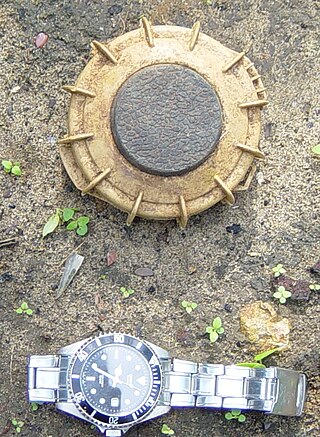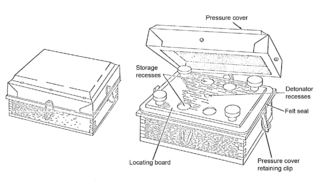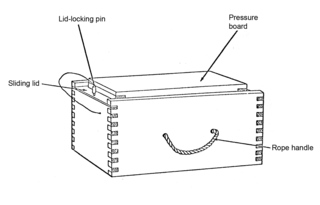Related Research Articles

A land mine, or landmine, is an explosive weapon concealed under or camouflaged on the ground, and designed to destroy or disable enemy targets, ranging from combatants to vehicles and tanks, as they pass over or near it.

A shell, in a military context, is a projectile whose payload contains an explosive, incendiary, or other chemical filling. Originally it was called a bombshell, but "shell" has come to be unambiguous in a military context. A shell can hold a tracer.

In anti-tank warfare, an anti-tank mine is a type of land mine designed to damage or destroy vehicles including tanks and armored fighting vehicles.

The Type 11 70 mm infantry mortar, was a muzzle-loading, rifled bore infantry mortar used by the Japanese. The Type 11 designation was given to this gun as it was accepted in the 11th year of Emperor Taishō's reign (1922). It was first used in 1922 and was the first mortar to be introduced by the Imperial Japanese Army. The Type 11 was later replaced by the Type 92 battalion gun.
The L9 bar mine is a large rectangular British anti-tank landmine. The bar mine's principal advantage is its long length, and therefore its trigger length. A typical anti-tank landmine is circular, and a vehicle's wheels or tracks, which make up only a small proportion of its total width, must actually press on the mine to activate it. To increase the probability of a vehicle striking the mine, the mine's effective trigger width must be increased.

An anti-personnel mine or anti-personnel landmine (APL) is a form of mine designed for use against humans, as opposed to an anti-tank mine, which target vehicles. APLs are classified into: blast mines and fragmentation mines; the latter may or may not be a bounding mine.
The POMZ, POMZ-2 and POMZ-2M are three types of Soviet-made stake mounted anti-personnel fragmentation mine. The POMZ mine was used during the Second World War. It was superseded by the POMZ-2, and later by the improved POMZ-2M. These mines have been used in numerous conflicts, including the Vietnam War and the Korean War.

The PMN series of blast anti-personnel mines were designed and manufactured in the Soviet Union. They are one of the most widely used and commonly found devices during demining operations. They are sometimes nicknamed "black widow" because of their dark casings.
The Type 96 mine is a Japanese large hemispherical landmine used during the Second World War. It entered service in 1936. The mine could be deployed in shallow water or on land, and used two lead alloy horn fuzes. The horns contained a glass vial filled with an electrolytic fluid, that when released triggered the electrical fuze detonating the mine.

The Type 99 (Hako-Baku-Rai) mine was a Japanese anti-tank weapon used during the Second World War. It entered service in 1939. Four magnets were attached to the casing made of hemp cloth, along with an external fuze. The fuze had a time delay, which enabled it to be used as an anti-tank hand grenade, or a demolition charge. Once the safety pin was removed, it was armed, striking the fuze ignited a powder delay train. The mine detonated after a five to ten seconds delay, giving enough time for it to be thrown.
The M6, M6A1 and M6A2 are a series of metal-cased, circular, heavy anti-tank landmines produced by the United States from May 1944 to May 1945.

A minimum metal mine is a land mine that is designed to use the smallest amount of metal possible in its construction. Typically, the only metal components are located inside the fuze mechanism which triggers detonation. Both minimum metal anti-tank and anti-personnel mines exist. Some designs contain virtually no metal at all, e.g., less than a gram. This is achieved by encasing the explosive charge in a plastic, wooden, or glass body, with metallic components limited to the few small parts in the fuze which can not easily be made from other materials, such as the spring, striker tip, and shear pin. Minimum metal mines are extremely difficult to detect using conventional metal mine detectors and usually require modern techniques, such as robotic Multi Period Sensing (MPS) equipment, to identify, but it is still extremely difficult to find non-metallic mines. These techniques are usually restricted to well-funded international mine clearing organizations and major militaries, making minimum metal mines especially pernicious where they are encountered.

An anti-handling device is an attachment to or an integral part of a landmine or other munition such as some fuze types found in general-purpose air-dropped bombs, cluster bombs and sea mines. It is designed to prevent tampering or disabling, or to target bomb disposal personnel. When the protected device is disturbed, it detonates, killing or injuring anyone within the blast area. There is a strong functional overlap of booby traps and anti-handling devices.

The TM-38 was a rectangular, metal-cased Soviet anti-tank mine used during the Second World War. The mine had a large raised rectangular central pressure plate with four reinforcing creases. When enough pressure was applied to the plate it collapses pressing down on a bolt connected to an internal lever. The lever pulls a retaining pin from the MUV fuze, which releases the striker, which impacts the MD-2 detonator.

The TS-50 is a 90 mm (3.5 in) diameter circular Italian blast resistant minimum metal anti-personnel mine designed and produced by Valsella Meccanotecnica (Italy).

The CC 48 is an Italian wooden cased minimum metal anti-tank mine that was used during the Second World War. The mine uses a shaped TNT explosive charge to produce a directional cutting effect. The mine uses two PMC/43 fuzes, but these can be replaced with PMC/42/2 anti-personnel fuzes, combined with weakening the lid this can make it sensitive enough to be detonated by the weight of a mine.

The CS 42/2 is an Italian wooden cased anti-tank mine used during the Second World War. The mine uses four PMC 43 buttons, which can be substituted for Model 42/2 fuzes to make it function as an Anti-personnel mine.

The CS 42/3 is an Italian wooden cased anti-tank mine used during the Second World War. Like the earlier CS 42/2 mine it uses four PMC 43 fuzes. It is a minimum metal mine, containing no metal.
The Anti-Tank Mine, General Service, Mark IV was a British anti-tank mine used during World War II. Externally the mine has a cylindrical main body filled with explosive either TNT or Baratol. The mine is covered by a pressure plate, which is attached to the mine body by four pins which sit in vertical slots in clips that fold up from the bottom of the mine. The mine uses the Shear-pin based Contact Mine Fuze No.3 Mk I. The fuze consists simply of a spring-loaded striker pin restrained by a shear pin. Sufficient pressure on the pressure plate presses the plate down on the head of the fuze, breaking the shear wire and releasing the striker, which is driven into the detonator by the striker spring.
In military munitions, a fuze is the part of the device that initiates function. In some applications, such as torpedoes, a fuze may be identified by function as the exploder. The relative complexity of even the earliest fuze designs can be seen in cutaway diagrams.
References
- HyperWar: Handbook on Japanese Military Forces
- TM-E 30-480
- "OP 1507 - Japanese Underwater Ordnance; Chapter 1 - Japanese Mines; Section 3 - Mine Type JB". michaelhiske.de. Retrieved 2023-03-22.